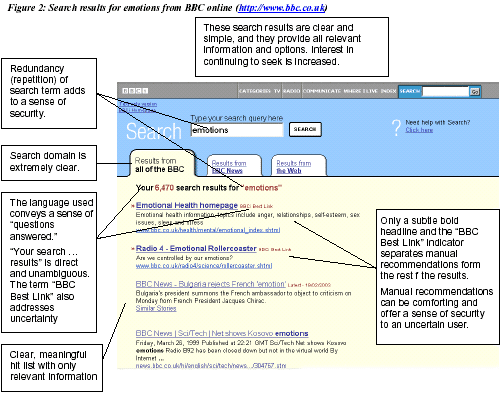James Kalbach on emotions and BBCi search
Unbeknownst to me at the time I started rifling through them, James Kalbach’s chi2003 Search UI workshop paper uses BBCi Search as one of its examples.
His paper is “I’m Feeling Lucky”: the Role of Emotions in Seeking Information on the Web [pdf 186kb], and outlines a:
framework for understanding users’ emotional states as they seek information.
Kalbach goes on to favorably compare the emotional response users have to a BBCi Search results page because of the efforts we have made to reassure the user as they follow their information seeking path.

Two interesting things struck me about the article and the interpretation of the BBCi Search team’s work (and I'm certainly not claiming any credit for the design myself).
The first was that Kalbach’s thinking was very similar to much of our own during the user testing process. The previous iteration of BBCi Search had the best links offset in a box above the tabbed interface, and we found that they were effectively in a blind spot, which is why they were moved into the run of the results. But subsequent to the launch of this version of search we did a lot of usability testing and a whole study into the ‘emotional response’ of the user to different web elements. The work went much further than just analysing an individual’s response to ‘big brands’ [sample question: how do you feel about Microsoft?] by concentrating on how they individually emotionally responded to graphics, icons, colour schemes etc. [sample question: how do you feel about this pixilated looking glass motif?]. The work is in place to inform us of how we can in the future design emotionally comforting interfaces.
The second thought was that our integration of our different technologies within the run of results works really well. Even James Kalbach didn’t notice that the two results underneath the ‘BBCi Best Links’ were labelled subtly differently and were from different datasets - the top one is labelled with ‘latest’ and a date with a url that just states ‘similar stories’. These are results injected above the regular indexed results if there is a news story that matches the keyword and crosses a specific relevance threshold within the last few days. It is one of those cases where instead of simply fretting that the user hasn’t seen every label and understood every nuance of the back-end, it is more important to make sure that every time a BBCi user searches for “iraq” they get the most recently published story, whether they notice we have done something “clever” or not.